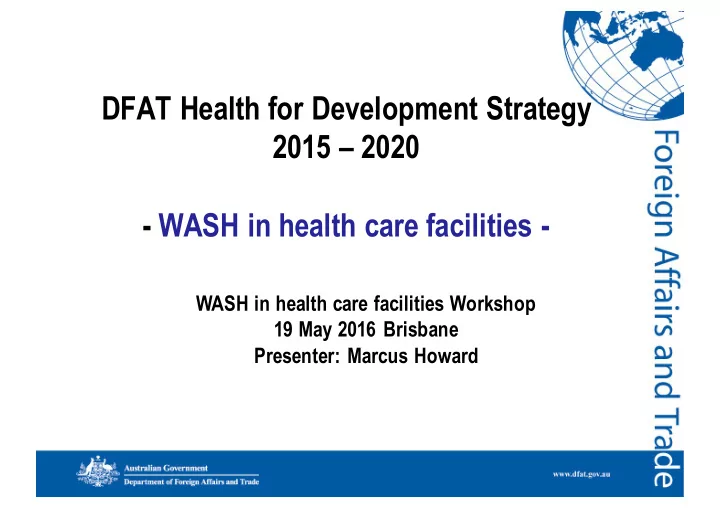

DFAT Health for Development Strategy 2015 – 2020 - WASH in health care facilities - WASH in health care facilities Workshop 19 May 2016 Brisbane Presenter: Marcus Howard
Presentation overview • Health and WASH in 2030 Agenda • Health and WASH in DFAT strategy and performance assessment • Improving WASH in health care facilities • Australian Aid examples
Implementation of 2030 Agenda – Why health care facilities matter ? • SDG 3 – Ensure healthy lives and promote well-being for all at all ages – Achieve universal health coverage including access to essential health care services • SDG 6 – Ensure access to water and sanitation for all. – Achieve access to sanitation and hygiene for all, paying special attention to needs of women and girls and the vulnerable.
Health for Development Strategy 2015-2020 Geographic focus East Asia and Pacific - our near region Outcomes : – Country level systems and services responsive to health needs – Strengthened regional preparedness and response to emerging threats Investment priorities : 1. Strengthen core public health systems and capacities to prevent, detect and respond 2. Address health threats that cross national borders 3. A more effective global response and international health architecture in our region 4. Access to clean water, sanitation and hygiene and good nutrition 5. Health innovation , new solutions
Strategy investment criteria • Demonstrate sustainable impact on health security and public health systems in low and middle income East Asia and Pacific countries • Leverage country policy reform, additional resources, and/or technical capability • Support DFAT regional and bilateral aid investment plans • Reduce fragmentation and improve aid effectiveness
WASH Theory of Change from WASH Performance assessment note (PAN)
Health Facilities and WASH : • Universal and equitable access to water and sanitation services and hygiene promotion – for households, schools, and health centres . • Health and Nutrition Outcomes – reduce under nutrition and stunting through improved hygiene and sanitation • Women's empowerment and gender equality – increasing access to quality health care facilities • Sustainable, affordable, and water and sanitation services, – delivered by government including through private sector provision.
Access in health care facilities Access to WASH in health care facilities is a basic pre- requisite for delivery of quality health care: • Functional and safe water and sanitation systems, available 24 hours a day • Staff and patient infection, prevention and control, and personal hygiene • Appropriate disposal of medical, surgical and human waste. Examples of program indicators from the WASH PAN : • % of health centres with safely managed WASH services • % of (sampled) population using hospitals, health centres and clinics providing basic WASH • % of (sampled) population using health care facilities with basic menstrual management facilities • % of health facilities with a handwashing facility with soap and water in or near sanitation facilities, food preparation areas and patient care areas
DFAT supported programs: examples: Cambodia Partnering to Save Lives (PSL) program – PSL is a reproductive, maternal and new born health program implemented by 3 NGOs (MSI, CARE and Save the Children) with the Cambodian Ministry of Health. Results so far -improved WASH in 34 health centres: • 157 staff trained in infection control • 26 double hole placenta pits constructed • Equipped with sanitation materials (e.g. brooms, rubbish bins) • 6 wells constructed, 13 water tanks installed 13 health centre toilets improved or constructed . •
DFAT supported programs: examples : Timor Leste rural WASH program “BESIK” – BESIK worked with the Ministry’s of Infrastructure and Health to improve community water and sanitation infrastructure and hygiene behaviours. Results: Improved WASH to health facilities : • BESIK I: 34 health posts and 14 health centres • BESIK II: 13 health clinics. Improved capacity of rural WASH sector enabling environment , access to safe water, improved sanitation use, improved hygiene behaviours.
DFAT supported programs: examples : • Indicators (by end of Vietnam – DFAT 2014) support for National • 92.8% (target 92%) Target Program which health clinics aims for 100% WASH • End target of 100% for coverage of health clinics will not be met clinics . • Operation and Maintenance (O&M) of clinic facilities remains a concern
DFAT supported programs: indirect examples : Solomon Islands upgrade of Honiara infrastructure – DFAT helped Solomon Water to improve their levels of water service (quality, quantity and reliability): • Result: increased daily hours of water supply in Honiara (where the National Hospital and health centres located) from 10 to almost 23 hours per day.
Questions ?????????????????????????????????????????
Recommend
More recommend